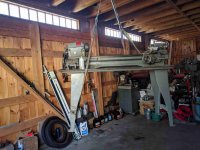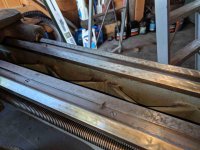kd1yt
Cast Iron
- Joined
- Dec 6, 2013
- Location
- Vermont, USA
My new-to-me 10k gap bed 4-1/2 ft lathe is on factory cast iron legs, with factory chip pan (pan is made of moderately thick pressed sheet steel with rolled edges. I plan to do a thorough disassembly and clean (it's seen little use but is grubby) and repaint the chip pan, which is peeling everywhere. I got to thinking- I've read people's remarks about 9" SB's benefitting from being mounted on a very rigid bench top, but in my case, even though the gap bed's bed is very stout- x braces throughout the length of the bed, no separate feet and sort of bridge-like sweeping buttressed ends on the bed- on mine, the legs essentially bolt to the bed (pan in between can't add a lot of rigidity) so that the lathe's bed has to serve as the main structural component.
Would I gain accuracy and performance by making everything more rigid if I fabricated an 'in between braced but relatively flat chassis' (flat to not stack a lot of additional height into the overall assembly that the legs would bolt to, and that would be self-supporting, with the chip pan and lathe then independently bolting on top of the 'chassis'? I'll try to add some photos of the lathe. Thanks in advance!
Would I gain accuracy and performance by making everything more rigid if I fabricated an 'in between braced but relatively flat chassis' (flat to not stack a lot of additional height into the overall assembly that the legs would bolt to, and that would be self-supporting, with the chip pan and lathe then independently bolting on top of the 'chassis'? I'll try to add some photos of the lathe. Thanks in advance!



